
Electronic english version since 2022 |
The newspaper was founded in November 1957
| |
|
Number 11 (4759) |
Historical cross-section
A few days of one year
Institute Dubna - 1965
Is a portrait of a theory possible?
Of a universe? Of a culture, of an epoch?
Boris Agapov, "The Mind climbs"
That year started with three significant events. On 7 January, the JINR Publishing Department received a manuscript by Boris Struminsky, a graduate student of Academician N.N.Bogolyubov, entitled "Magnetic moments of baryons in the quark prototype". Three incomplete pages, one of which has solid formulae. And in a footnote, very briefly, as if in passing, a remark that quarks should be attributed to another quantum number to comply with the Pauli principle. Three months later, this idea will be developed in the joint research of Bogolyubov, Tavkhelidze and Struminsky and in autumn, the future Nobel winner J.Nambu will call the new quantum number "color" and liken it to an electric charge - the first step toward quantum chromodynamics, on which today's worldview is based.
The second significant event happened a few days later: on 12 January, Struminsky's scientific supervisor Academician Bogolyubov was elected as the new JINR Director at a meeting of the Committee of Plenipotentiaries. His predecessor, Dmitry Blokhintsev that was elected to this position three times, leaves for LTP, in place of Nikolay Bogolyubov. And he makes his choice consciously. For nine years of directing the Institute he begins to be weighed down by administrative concerns, he wants to do something else for science. But it is not only his choice. He was pushed to this choice by the following circumstance: a few months before, in September 1964, JINR Vice-Director Heinz Barwich asked for political asylum in the USA. And as a consequence, the third event at the very beginning of the year: on 22 January, the JINR staff solemnly retired the Head of the regime A.M.Ryzhov.
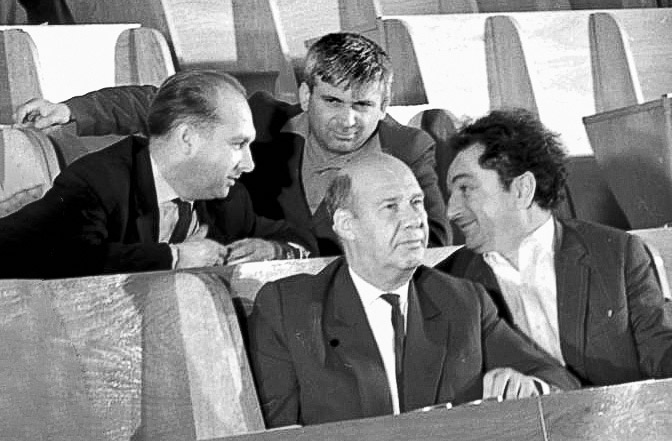
D.I.Blokhintsev: "There is a colossal number of tasks ahead..."
LTP is a quiet backwater compared to the Institute as a whole. Dmitry Blokhintsev plunges headfirst into elementary particle physics, to put it in the rough language of the poster. There is no theory as such. So, the first sketches. Many people work in this area. Among them are the patriarch of quantum mechanics Werner Heisenberg and the new generation physicist Tulio Regge. The young have the advantage of being able to work at higher power levels. Physicists live in anticipation of a scientific revolution. A new breakdown of previous ideas is expected. Academician I.E.Tamm said that he dreams of living to the time when the final theory of elementary particles will be constructed and he will still be able to understand it.
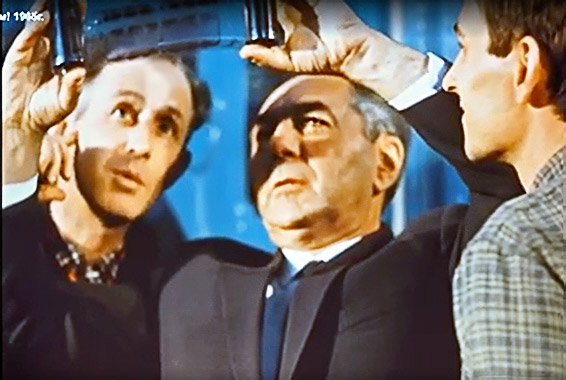
В.P.Dzhelepov: "There is material..."
And at the end of the first half of the year, the first test of endurance for JINR as an international scientific centre: the Chinese leave Dubna. On 8 June, the Chinese representative Li Yee reads out an official statement at the CP meeting. He speaks fluent Russian, but reads the statement in Chinese. Dmitry Blokhintsev makes a sign to the interpreter that was excited: no need, everything is clear as it is. Li Yee says the last sentence in Russian: "Goodbye, dear comrades!" "They left in complete silence. Only the shutter of Yury Tumanov's camera clicked that captured this historic event," Dmitry Blokhintsev wrote in his diary. The Chinese left and the JINR budget decreased by 20%. JINR was threatened with staff reduction. And everything fell on Nikolay Bogolyubov... From Dmitry Blokhintsev's diary: "Of course, I did not expect any special joy for him (N.N.Bogolyubov - A.R.) at this post, yet I did not expect such a sad situation when the USSR AEC heads the destruction of the Institute. I wrote two letters "upstairs". One is mine and Bruno's, the second is Hyena's. The second one is in the old, "Kurchatov" style: everything is great, excellent but only in one respect there is a danger that the USA will overtake us and we make a proposal that will allow us..."
But the Institute is still on the increase. Boris Neganov realized a technique of lowering the temperature by dissolving helium-3 in helium-4. His cryostat reached a record temperature of thousandths of a kelvin. A major achievement in cryogenics! At this temperature, polarized targets, indispensable in spin physics, are able to retain polarization for several months while the experiment is in progress... Two years later, a film will be shot about Boris Neganov, in 1981, he will be awarded the Lomonosov Prize and in the 1990s, he will become an Honored Scientist of the Russian Federation. As a chief researcher at LHE V. A. Nikitin once remarked, Boris Stepanovich lacked only one thing for the Nobel Prize - American citizenship.
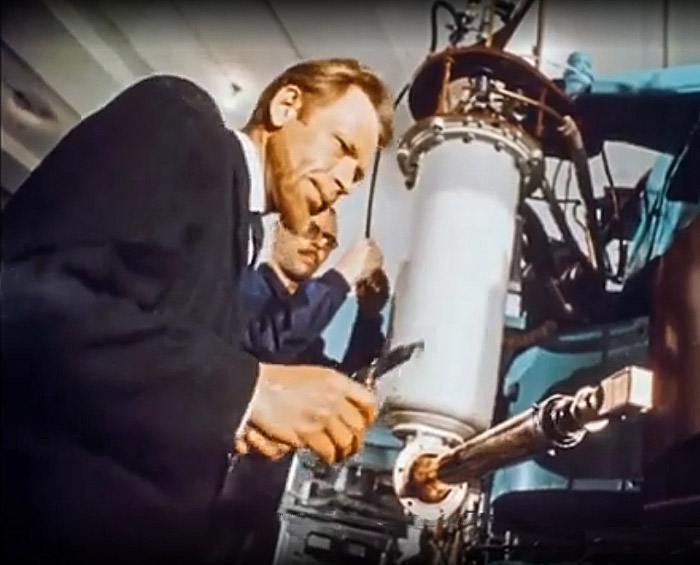
Boris Neganov and his "refrigerator" ...
...and his team
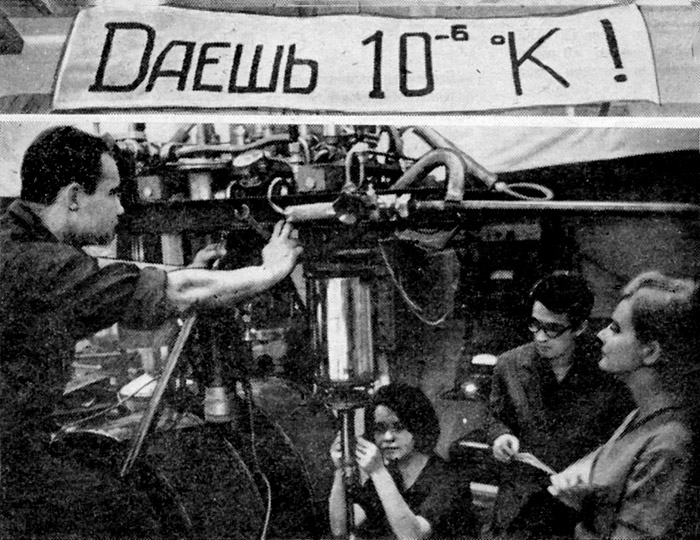
April of this year was marked in the USSR State Register of Discoveries by the priority of the discovery of the element 103. It was discovered by two young physicists from the Laboratory of Nuclear Reactions - Evgeny Donets, Vladislav Shchegolev and their colleague radiochemist Viktor Ermakov. Two years earlier, the element 102 had also been obtained by "Soyuz Trekh" and the priority of this discovery was assigned exclusively to Dubna. Dmitry Blokhintsev said on this occasion: "Perhaps this is the first Dubna research in which it is impossible to point out any error.
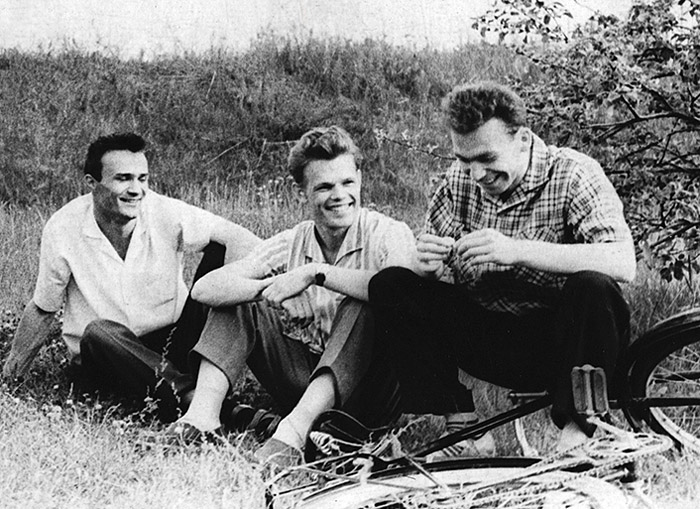
"Soyuz Trekh": the authors of the elements 102 and 103
One of the "Soyuz Trekh", Vladislav Shchegolev, in the same April announces to the public that a literary association is established in Dubna. Science is not the only thing man lives by. And already in June, young Moscow poets come to us and together with them - bards of Yuly Kim and Yury Vizbor, familiar from their songs. From Dmitry Blokhintsev's diary: "I liked these people very much - thinking and with a troubled conscience... And of course, Kim is good with his "Kolkoy the Hooligan" and songs about the war of 1812..." But the exhibition of young Moscow artists looking for new ways in art failed - the initiative was cut off at the root. Even the intercession of Dmitry Blokhintsev did not help. The initiator had a "heart-to-heart" conversation with the first secretary of the City Party Committee, at that time it was N.P.Fedorov, the future director of DEP. As Vladislav Alexandrovich recalled later, Nikolay Pavlovich quickly realized that it would not be possible to sell and invited him to take a walk in the shady alleys of Dubna, away from prying ears and at the end, he suggested: join the party, boy, we need such people!
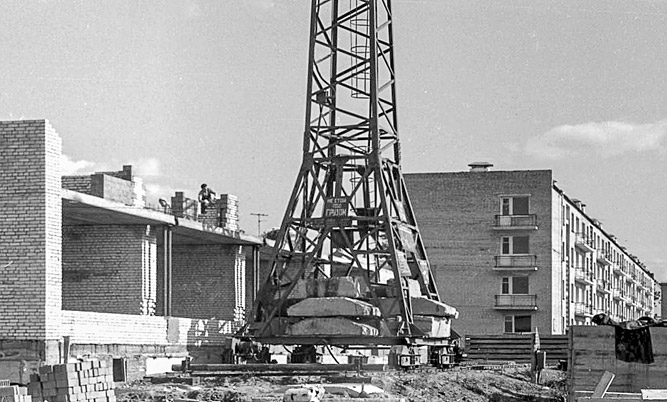
The first ten-story building of Dubna is under construction
And at about the same time, Nikolay Asanov's novel "Physicists-Lyricists" is hotly discussed in the Scientists' Club. Over the course of three chapters, the story is set in Dubna and some of the characters are so recognizable that Alexey Tyapkin couldn't stand it: this guy is the best water-skier there and everyone, of course, thought it was me! Editor of the magazine "Ogonek" Anatoly Sofronov addressed a letter to M.G.Meshcheryakov, brought out in the story under the surname Bogatyrev, with a request to evaluate the work of the writer. A positive response was received and the next year, the story under the title "Goddess of victory" appeared in "Ogonek".
The Institute newspaper "For communism" of that time is an inexhaustible source of knowledge about Dubna in the 1960s. In the next issue, the correspondent Yury Tumanov reports that enthusiasts of diving Leonid Golovanov and Igor Skryl, Igor Goncharov and Leonid Silvestrov are preparing for all-union competitions. One of them, Leonid Golovanov, then even managed to participate in the adventure movie "Aqualungi at the bottom", the latter that summer was filmed in the Crimea. And about the same time, in the Crimea at the exit from the sea was detained a man in a foreign wetsuit "Calypso". When asked who he was, this man with a noticeable accent said that he was Academician Pontecorvo. After that Bruno Maksimovich and it was him, was escorted to the lockup of the USSR Border Troops and he spent twenty-four hours on a diet for border violators that he later recalled as another amusing adventure in his life.
And Dubna, as it became clear that year, is also a school of water skiing of the Nekhaevsky brothers: on 22 July, at the competitions in Khimki, the pupil of the school of Galina Litvinova won a gold medal in slalom and became the champion of the country. The Badge "Master of Sports of the USSR" was handed to her by Vice-Admiral Lev Panteleev and next to her that is especially valuable for us, the first cosmonaut of the planet Earth stood and smiled his famous Gagarin's smile. And who informs the readers of the Institute newspaper about it? The same Yury Tumanov that later replaced the dictaphone with a camera and became a photo chronicler of Dubna Institute.
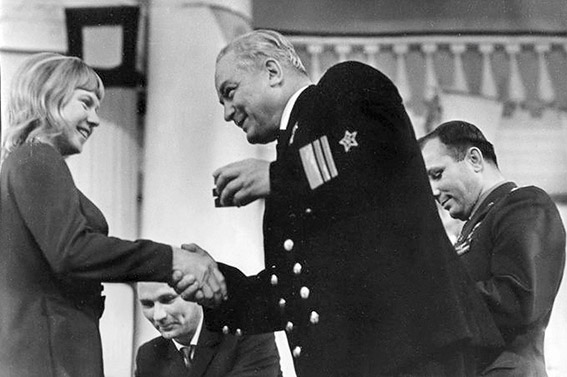
Awarding of Galina Litvinova
July is the peak of summer. People go on vacations, Moscow archeologists wind down their work. As Head of the expedition of the State Historical Museum, Candidate of Historical Sciences Alla Uspenskaya reports in the Institute newspaper for 28 July, as a result of three-year work in Ratmino, indirectly confirmed the event noted in the Novgorod chronicle, that Prince Mstislav Mstislavovich Udatny in winter-spring, 1216 "...wandered down the Volz and burned Shesha and Dubna and Ksnyatin and all the Volga region". Traces of fire, household items belonging to that time were found. Along with professional archaeologists, the residents of the city - school teachers Yu.F.Ivanova and I.Z.Ososkova and their students participated in the excavations. Thus, the city of physicists began to take on the appearance of Old Russian Dubna (that, however, was not to everyone's liking).
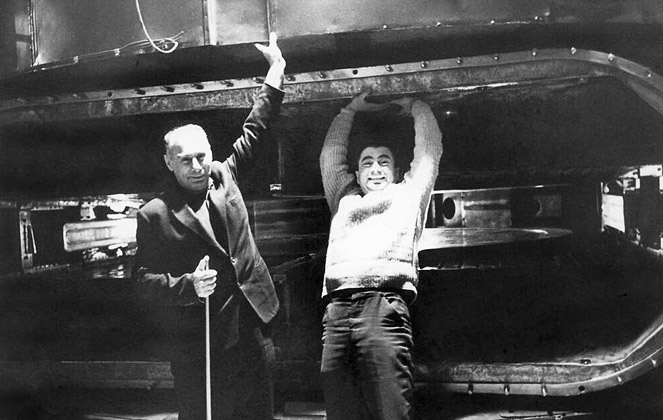
U-300 - for the Lenin Prize!
And again, Dubna is in the centre of attention. A film crew from the studio "Mosnauchfilm" is coming to shoot the final eight minutes of the documentary "Man and the atom". In the next issue of the newspaper, tireless Yury Tumanov tells how the movie is filmed. All according to a pre-written script. Except, of course, the seminar theorists - these people can only speak in their own words and each time, different. For two days, the conference hall of LTP, Tumanov writes, turns into a shooting pavilion. No matter what the theorists say, they can't be heard - from the sharp discussion of Viktor Melnikov's report, the audience can hear only two or three phrases of the speaker himself and the same number of phrases of Head of the seminar D.I.Blokhintsev that summarizes the results. By the way, you can watch the movie, it is available on the Internet. At the 55th minute, familiar faces, basic facilities, traces of unseen particles... are flashed.
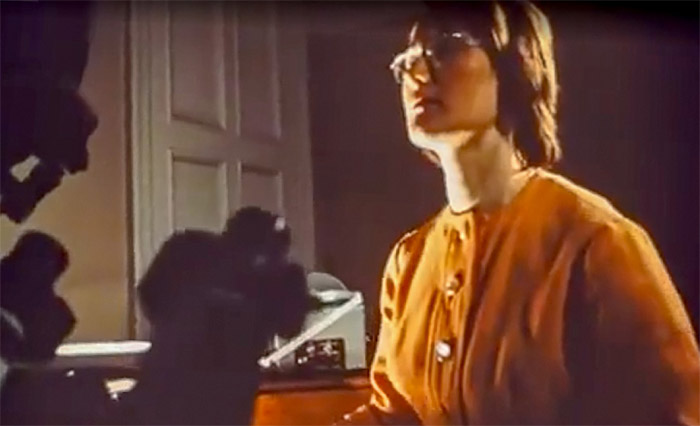
A glimpse into the microcosm
In that year that was fruitful for discoveries (five of them were included in the State Register of Discoveries of the USSR), the last result was obtained almost under the Kremlin chimes. It entered the State Register of Discoveries of the USSR with priority on 23 December, 1965. If nature had been organized a little differently, this discovery could have enriched mankind. We are talking about mu-catalysis. The phenomenon itself had been known before. The issue was how many nuclear fusions a muon could provide in its short, two-microsecond life. The task was the energy output: it was many orders of magnitude less than that used to produce the muons themselves. And so, when analyzing how muons affect some processes in the microcosm (they developed a background and closed the picture of what was happening) MSU graduate Vladimir Filchenkov noticed that in a certain range of temperatures the rate of production of mesomolecules sharply increases. The muon (this useless creation of nature, why was it needed in nature, physicists thought) seemed to open the way to cold nuclear fusion! Alas, it only opened the door. The energy released in the synthesis of hydrogen isotope nuclei has increased by three orders of magnitude but it is still not enough to compensate for the cost of muon production... Academician L.I.Ponomarev that has been working on the issue of mu-catalysis for several years, said in the late 1980s: if only the world constants could be "tightened up" a little... However, he added philosophically, "if these are roses, they will bloom, where can they disappear" (Italian folk wisdom).
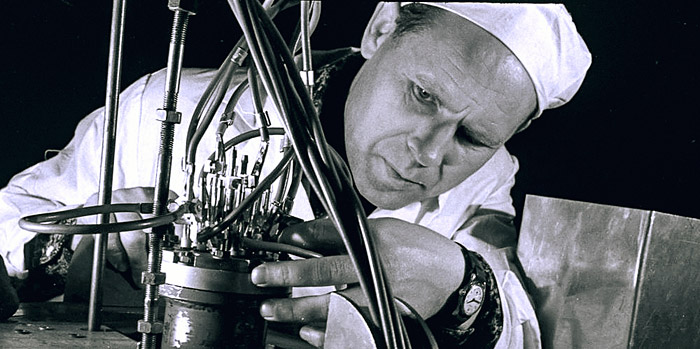
I.M.Matora and the microtron
This is a historical cross-section, not without subjectivism and taste. For some people, that year was important due to completely different events. Ivan Matora and Robert Kharyuzov, for example, that year completed development of the microtron - an electron accelerator that reduced the duration of neutron flashes produced by IBR by dozens of times, making nuclear spectroscopy possible. Yury Prokoshkin was honored with the Kurchatov Prize. Boris Arbuzov and Rudolf Faustov defended their doctoral theses. Someone (and more than one) in that year improved their living conditions and for Nikolay Govorun, Head of the Mathematical Department of the Centre, the year became a turning point in his scientific destiny: he went to CERN, saw how physicists there themselves write data processing programmes in Fortran, also tried it and returned with a firm intention to make a translator from this language on the newest Russian computer BESM-6.
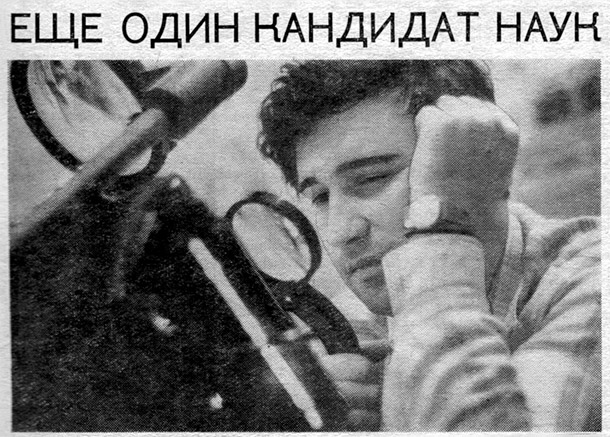
On 17 June, Boris Struminsky defended his thesis on the same day as Vitaly Shelest, the son of the First Secretary of Ukraine and therefore, as Olga Serdobolskaya, Boris's classmate, recalled with pleasure many years later, everything was on the tables at the Dubna restaurant that evening. And there were policemen on duty outside the restaurant, without authorization to enter. And no one asked at whose expense the banquet was at....
Alexander RASTORGUEV